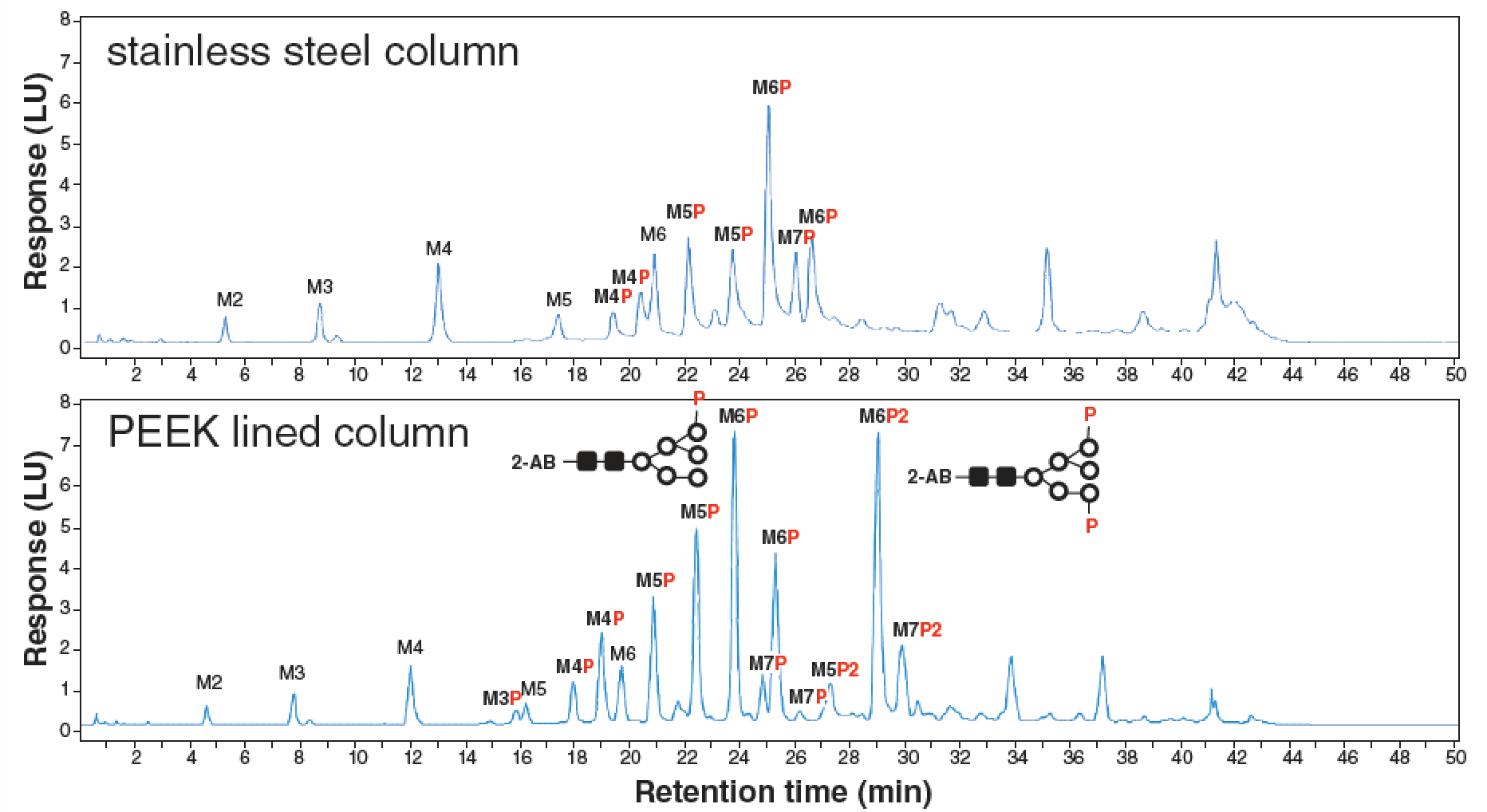Development of a “Freeze-Pour” Sample Preparation Method for the GC Analysis of Semivolatile Flavouring Chemicals Present in E-cigarette Refill Liquids
HS-GC analysis is presented as an excellent method for the analysis of high volatile components in e-liquids. For the analysis of semivolatile ingredients, an additional sample preparation step is proposed based on a LLE followed by a freeze-out of the matrix components.
During the past decade, e-cigarettes have become increasingly popular. To guarantee their safe use and to comply with the notification requirements of the EU Tobacco Product Directive, the EU member state regulatory authorities need information about the exact composition of the e-liquids and their emissions. However, one of the challenges encountered during the analysis of e-liquids is the presence of the highly abundant e-liquid matrix components propylene glycol and glycerol. In this study, headspace gas chromatography (HS-GC) analysis is presented as an excellent method for the analysis of high volatile components in e-liquids. For the analysis of semivolatile ingredients, an additional sample preparation step is proposed based on a liquid–liquid extraction (LLE) followed by a freeze-out of the matrix components. The developed method was successfully validated in accordance with the validation requirements of ICH guidelines for the quantification of four flavourings with a potential health concern for e-cigarette users.
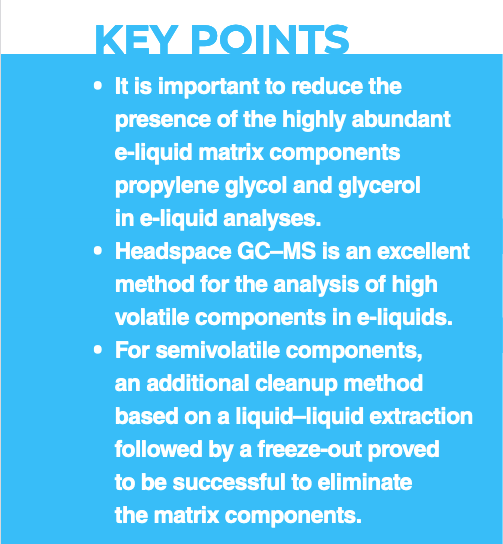
Since its introduction more than 10 years ago, the e-cigarette has become a popular consumer product. To guarantee its safe use and to comply with the notification requirements of the EU Tobacco Product Directive (1), analytical characterization of the refill liquids (e-liquids) used for e-cigarettes is essential. The most prominent methods used for the analytical assessment of e-liquids in general are liquid chromatography (LC) and gas chromatography (GC).
LC is mainly used for the analysis of nicotine, nitrosamines, and nonvolatile flavourings (2–5). The sample preparation for LC methods is, in most cases, limited to a simple dilute-and-shoot approach because of the “simple” e-liquid matrix composed of propylene glycol and glycerol. So far, sample preparations involving extractions in e-liquids have only been explored for the analysis of tobacco nitrosamines and phtalates (6,7).
GC is the most commonly applied technique for the analysis of e-liquids because they mainly contain volatile components. As such, GC has been used for the analysis of e-cigarette ingredients, additives, and contaminants (8–10). Similar to LC, the sample preparation methods most frequently used with GC are dilute-and-shoot approaches using organic solvents. Yet, Hutzler et al. (11) have also described alkaline and acidic extractions to cover a wide range of components. Other sample preparations combined with GC analysis used for e-liquids are thermal desorption and solid-phase microextractions (SPME), especially for highly volatile organic compounds (12,13).
The dilute-and-shoot approach as well as the thermal desorption method result in a high abundance of the matrix components propylene glycol and glycerol in the chromatographic system, unless high split ratios or higher dilutions are used, which would lead to a loss in sensitivity. This abundancy of matrix components will have an impact on the chromatographic performance and could affect the detector performance. Furthermore, the viscous and greasy properties of the e-liquid matrix may also result in a faster deterioration of the GC columns and deactivation of the active groups. These issues are less a problem for LC methods, because of the robust columns and higher dilutions. To avoid the e-liquid matrix during the GC analysis, proper sample preparation is needed to improve the life span of the column and reduce the total number of cuts of the GC inlet. Often, the target components that need to be analyzed are also miscible with propylene glycol and glycerol. Therefore, it is quite challenging to simultaneously extract all analytes.
This article presents a strategy for GC analysis of flavourings in e-liquids. The screening methods were developed using representative flavourings for the main chemical groups (aldehydes, [di]ketones, pyrazines, esters, alcohols). The flavourings were further divided into two subsets for which different GC methods were developed, that is, high and semivolatiles.
Considering the high number of flavouring chemicals used in e-liquids, the developed method for the semivolatile components was validated using a selection of four compounds that previously were predicted to be either genotoxic (2-furyl methyl ketone, pulegone, estragole) (14) or an inhalation toxicant (cinnamaldehyde) (15).
Experimental
Standard Solutions: For the development of the screening GC–mass spectrometry (MS) method, the test solution consisted of a mixture of the following standards in a concentration of 10 mg/mL in hexane or ethanol (according to the solubility): ethyl butyrate, benzaldehyde, limonene, benzyl alcohol, linalool, alpha‑terpineol, citral, trans-cinnamaldehyde, damascenone, eugenol, vanillin, ethyl vanillin in hexane, 2,3-butanedione, 2,3-pentanedione, acetoin, trimethylpyrazine, acetylpyrazine, L-menthol, carvone, methyl 2-aminobenzoate, methyl cinnamate, piperonal, maltol, gamma-octanoic lactone, and ethyl maltol in ethanol.
For the validation of the analysis of the selected flavourings (2-furyl methyl ketone, pulegone, estragole, and cinnamaldehyde) the calibration standards were prepared from a 10 mg/mL stock solution in hexane. The stock solutions were stored in amber glass at 4 °C. A separate 10 mg/mL stock solution was prepared for the internal standards o-methyl anisole and 2-chlorobenzaldehyde. The calibration solutions were obtained by diluting the stock solutions into the different concentrations 1 µg/mL, 10 µg/mL, 25 µg/mL, 50 µg/mL, 75 µg/mL, and 100 µg/mL with hexane as solvent and the internal standard at 10 µg/mL After vortexing for 10 s, 150 µL was transferred into a 10 mL headspace vial. The validation samples were prepared at three concentration levels in triplicate. To prepare the validation samples, a propylene glycol–glycerol matrix was spiked with the reference standards of the target component. The most common matrix ratio consists of 60% propylene glycol and 40% glycerol. Therefore, 0.5 g of 60:40 propylene glycol–glycerol matrix was spiked with a 10 mg/mL stock solution to obtain 10 ppm, 50 ppm, and 100 ppm formulations and with the internal standard solution to obtain a final concentration of 10 µg/mL after the extraction procedure. All the used standards were purchased from Sigma Aldrich.
Extraction Procedure: The group of flavourings were divided into two subsets: high and semivolatiles. For the high volatiles, a dilute-and-shoot approach was applied in combination with headspace injection. The samples were diluted by dissolving 1 g e-liquid sample in 10 mL dimethyl sulfoxide (DMSO) of which 300 µL was transferred to a 10 mL sealed vial. For the semivolatiles, higher headspace temperatures were needed. Therefore, to minimize the interference of the matrix components propylene glycol and glycerol, a liquid–liquid extraction (LLE) was applied as a sample preparation step. The substances were extracted with hexane followed by separation through a “freeze-and-pour” technique. For each sample extraction, 0.3 g of the e-liquid was weighted in a glass vial of 20 mL, mixed with 3 mL hexane and covered with a Teflon seal. During the first extraction step, vials were vortexed for 10 s and then sonicated for 3 min at 50 °C. Afterwards, vials were transferred to a cooling bath of −78 °C (dry ice dissolved in acetone) for 2 min, followed by 1 min centrifugation at 860 g. Three quarters of the supernatants were transferred to a glass vial. These extraction steps were repeated for a second time by adding another 3 mL of hexane. After extraction, 300 µL of the combined extracted solutions of two extraction cycles was transferred to a headspace vial of 10 mL.
GC–MS Conditions: The screening of the high volatiles was performed on an Agilent 7890B gas chromatograph with an Agilent 7000C triple quadrupole mass spectrometer and equipped with a G188A static headspace sampler (Agilent Technologies). The incubation temperature was maintained at 85 °C with an equilibration time of 15 min. The injector port was kept at 160 °C in split injection mode (split ratio 15:1), while the temperatures of the headspace loop and the transfer line were maintained at 100 °C and 120 °C, respectively. The substances were separated on a 60 m × 0.25 mm, 0.25-μm VF-5 ms (5% phenyl–95% methylpolysiloxane) capillary column and an integrated guard column of 10 m (#CP9013, Factor four, Agilent). Helium carrier gas was used at a constant flow of 1.0 mL/min. The initial oven temperature of 45 °C was maintained for 10 min, followed by a temperature ramp of 40 °C/min to a final temperature of 250 °C. The total run time was 18 min. The mass spectrometer was operated in electron impact (EI) mode at 70 eV. Temperatures of the ion source, the quadrupole, and the interface were set at 230 °C, 150 °C, and 280 °C, respectively. The identification was performed in full-scan mode from 25 to 400 m/z.
The second screening method was applied to detect the semivolatile substances in e-liquids. Thus, the incubation temperature was maintained at 145 °C with an equilibration time of 15 min to obtain full evaporation mode. The injector port was kept at 160 °C in split injection mode (split ratio 15:1), while the temperatures of the headspace loop and the transfer line were maintained at 150 °C and 155 °C, respectively. The GC–MS conditions were similar to those of the method for high volatiles, except for the temperature gradient. The temperature gradient started at 65 °C (held for 3 min) and raised at 5 °C/min to reach 90 °C. The temperature gradient continued at 20 °C/min, until 185 °C, followed by another fast decrease in temperature to 100 °C by 30 °C/min, which finally increased with 35 °C/min until 290 °C (held for 3 min). The total runtime of the method was 24 min.
Results and Discussion
Method Development and Optimization: The aim was to develop a general GC–MS screening method for flavouring components present in e-liquids. It is, however, impossible to include every compound that can be potentially found as a flavour in e-cigarettes. The method was therefore developed based on frequently used representatives for each flavouring group (aldehydes, [di]ketones, pyrazines, esters, alcohols). The components chosen for method development were: 2,3-butanedione, 2,3-pentanedione, acetoin, ethyl butyrate, trimethylpyrazine, benzaldehyde, limonene, acetylpyrazine, benzyl alcohol, linalool, L-menthol, alpha-terpineol, citral, carvone, cinnamaldehyde, eugenol, damascenone, methyl 2-aminobenzoate, methyl cinnamate, piperonal, vanillin, ethyl vanillin, maltol, gamma-octanoic lacton, and ethyl maltol. Nicotine was added to check for possible interference.
First, the appropriate solvent was chosen to assure the solubility of the standards and eliminate solvent interferences for the selected compounds. Of the four tested solvents (DMSO, ethanol, methylene chloride, and hexane), hexane was finally selected as most optimal. Next, the chromatographic method was developed through screening of the most appropriate column; 5% diphenyl equivalent/95% dimethylpolysiloxan and 6% cyanopropylphenyl/94% dimethylpolysiloxan columns were tested and the GC injection parameters and oven temperature program were optimized. However, it was noticed that two separate methods were necessary to detect all selected flavourings because of the wide variability in volatility among the different compounds andinterference of other substances. The group of flavourings were divided in two groups: high and semivolatiles. The high volatile flavouring group consisted of the flavourings 2,3-butanedione and 2,3-pentanedione, which could not be detected with the original method (Figure 1) as these substances interfered with the hexane solvent peak. For the separate method of the high volatiles, DMSO was selected as solvent.
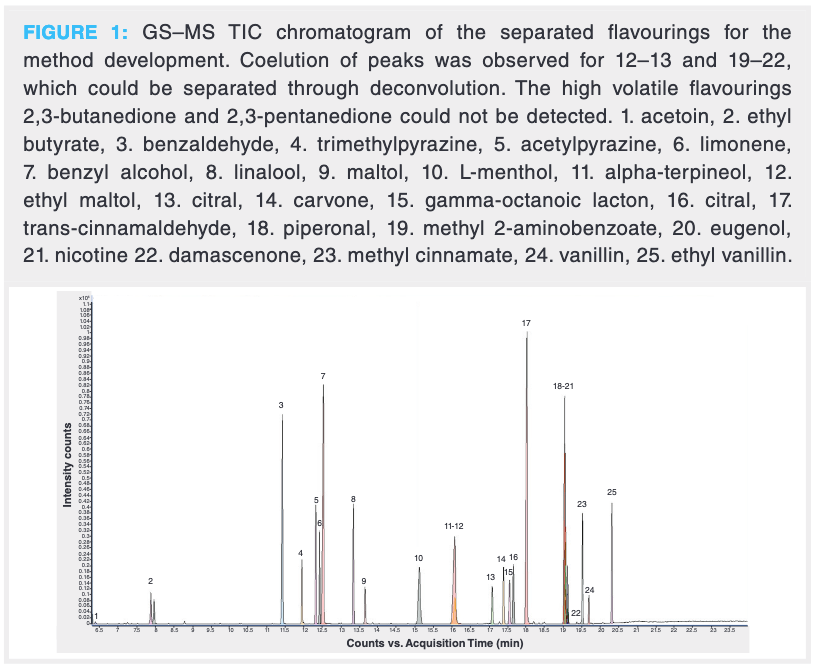
Once the chromatographic method was obtained, an appropriate injection mode was chosen and the sample preparation was developed to minimize the presence of the matrix (propylene glycol, glycerol) during the analysis.
For the high volatile flavourings, injection through headspace was considered to limit the transfer of the matrix to the column. The headspace temperature was chosen to obtain an optimal transfer of the target components to the headspace with minimal transfer of the matrix components. The optimal headspace temperature was 85 °C.
For the semivolatiles, full evaporation headspace injection (145 °C) was considered instead of direct injection. However, extra sample clean-up was still needed to avoid transfer of the matrix components to the column. Different sample clean-up techniques including solid-phase extraction (SPE), distillation and liquid–liquid extraction were tested. Both SPE and distillation did not result in a separation of the matrix components. In case of distillation, the boiling points of propylene glycol and glycerol were similar to the analyzed components and therefore excluded as an option, once the pilot experiment showed no acceptable result. SPE was performed with C18 cartridges (0.5 g, 6 mL). After conditioning with methanol and sample load, the cartridge was cleaned with water and then eluted from the sorbent with methanol. This did not result in a decrease of matrix components in the chromatogram. The most appropriate method was a liquid–liquid extraction. The extraction was further optimized with respect to solvent, extraction cycles, and extraction time. However, the technique for separation of the organic layer was not satisfactory.
In the classical approach of liquid–liquid extraction, the separation of the multiple layers is done with a funnel or by pipetting the relevant layer from the whole. However, we observed that the presence of the matrix components was still significant in the organic layer.
Therefore, a separation technique based on flash cooling, as previously described for cosmetics (16), was applied. This “freeze-pour” approach uses a flash cooling technique for separation after the addition of an organic or an immiscible solvent. The extract as a whole was put in an ice bath at -78 °C to freeze and solidify the matrix components glycerol and propylene glycol. Next, the organic phase (hexane) was poured into a vial for further analysis without the matrix components as these were still in a solid phase. This way has proven to eliminate the matrix components as much as possible.
As an example, a commercial e-liquid was analyzed with both separation techniques. The same dilution was used to compare the liquid–liquid extraction with separation through pipetting of the organic phase. The chromatogram in Figure 2 shows that the amount of matrix injected in the column was limited after the freeze‑pour extraction and the recoveries were the same or better. This sample preparation technique can also be used with other GC injection techniques.

Quantification of Potential Toxic Flavourings: The method for semivolatiles was applied for the quantification of the potential toxic flavourings 2-furyl methyl ketone, pulegone, estragole, and cinnamaldehyde (14,15). For their GC–MS/MS analysis, the precursor and product ions were chosen for each target component to guarantee minimum interferences. Multiple reaction monitoring (MRM) parameters and retention times are reported in Table 1. The original chromatographic method was shortened to 18.5 min. After a 1 min hold on 65 °C, a temperature ramp was set at 10 °C/min until 240 °C. The chromatogram of the separation is shown in Figure 3. The general internal standards o-methylanisole and 2-chlorobenzaldehyde were chosen, although deuterated molecules of the target component are preferable.
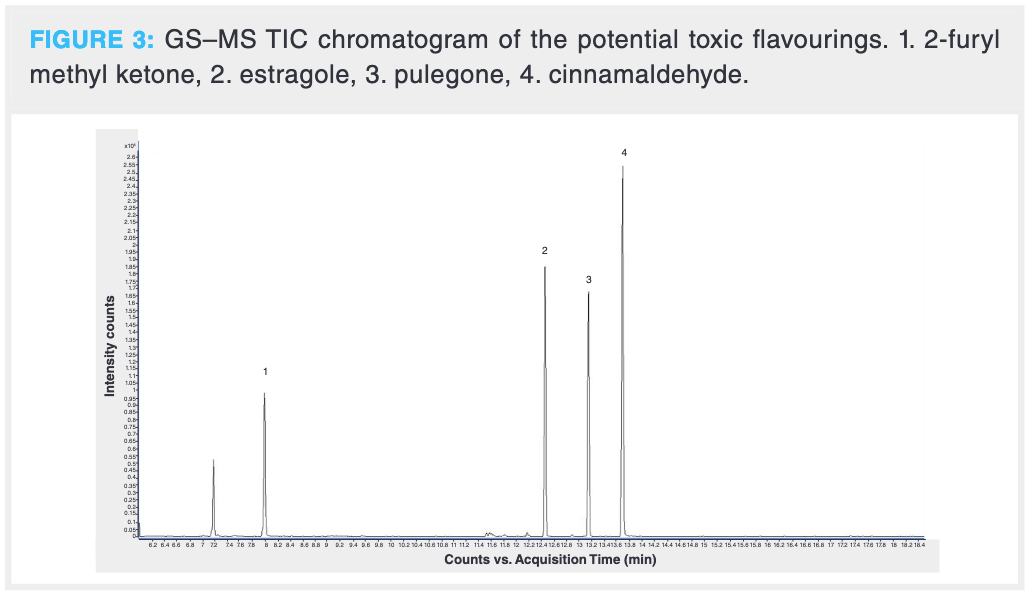
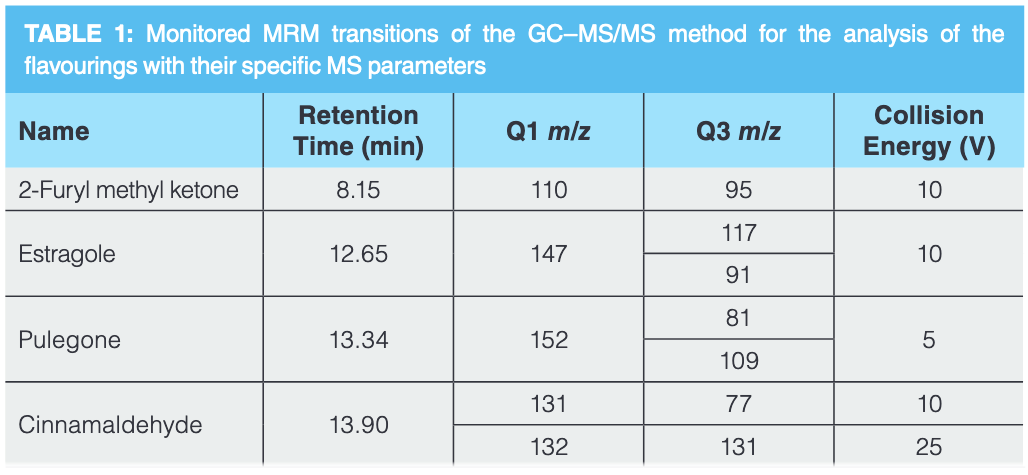
Method Validation: Method validation was subsequently done for the four selected compounds in accordance with the International Council for Harmonisation of Technical Requirements for Pharmaceuticals for Human Use (ICH) guidelines (17).
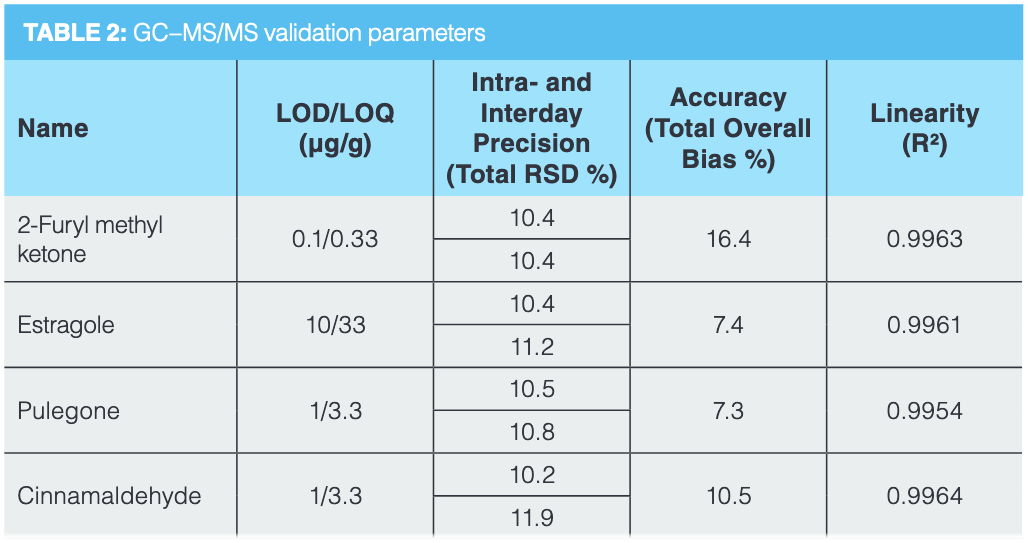
All validation parameters are reported in Table 2. The method’s limit of detection (LOD) and limit of quantification (LOQ) were determined based on the signal-to-noise ratio (S/N = 3 for LOD and S/N =10 for LOQ) of the quantifier ion peaks in the sample matrices. The estimated LODs and LOQs of the method ranged from 0.1 to 10.0 µg/g and from 0.3 to 33 µg/g, respectively. All calibration curves ranging from 1 to 100 µg/mL showed good linearity with correlation coefficients (R²) greater than 0.99. Method precision was assessed based on replicate analyses of spiked samples (three concentration/three replicates). The validation samples were spiked with 10, 50, and 100 µg standards in 1 g e-liquid (60:40 propylene glycol–glycerol). The precision was then calculated based on the percent relative standard deviation (%RSD). The %RSDs were <15%. Method accuracy assesses how close the experimental value is to the expected value. Method accuracy was expressed as the bias to the known amount of analyte in the spiked sample. As shown in Table 2, the bias from the spiked samples was between 7.3% and 16.4%, demonstrating good accuracy of the method, which also indicates that no analyte loss occurs during sample preparation.
The extraction recovery was determined to confirm the minimal loss of the analyzed compound during the extraction (Table 3). A recovery of at least 85% was accepted as high enough for this application. The recoveries with the freeze-pour approach were higher than the extraction with separation through pipetting.

Proof of Applicability: To prove the applicability of the freeze-pour extraction method for semivolatile flavourings, previously screened samples were selected that were positive for one of the target flavourings of the validated method for further quantification. This initial screening resulted in a small sample set of six e-liquid samples. The results are summarized in Table 4. Because of confidentiality the analyzed liquids are anonymized. Whether these concentrations of flavourings actually pose a health risk via e-cigarette vaping should be further assessed and will be further investigated.
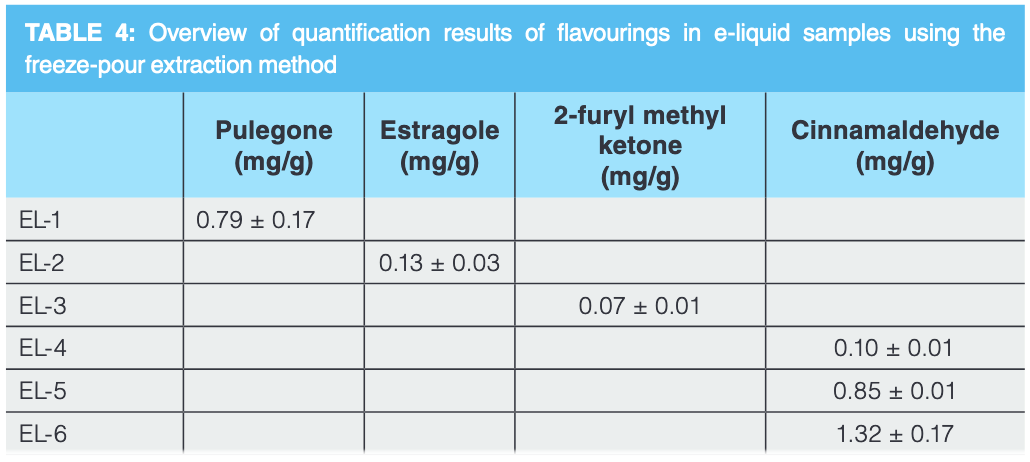
Conclusion
Most GC methods used for the analysis of e-liquids apply the dilute-and-shoot approach for practical reasons. For routine analysis it is recommended to limit the presence of high amounts of propylene glycol and glycerol in the GC instrument and mass analyzer. In this study, a strategy was developed for the GC analysis of flavouring chemicals present in e-liquids. It will become more important to analyze these flavours for regulatory purposes since the manufacturers need to notify their presence to the EU competent authorities. Because of the wide range of flavours available, two methods were developed, one for the high volatile and one for the semivolatile flavourings, as both groups could not be analyzed with just one method. In the case of high volatiles, the use of headspace injection was sufficient to limit the amount of matrix components. For the semivolatiles, high headspace temperatures were used, and thus the transfer of matrix components was inevitable. Therefore an additional sample preparation step was included. In this study, we successfully developed a clean-up technique that eliminates most of the matrix components. The sample preparation is a liquid–liquid extraction with hexane followed by a freeze out of the matrix components using a flash cooling technique. Because of the solidification of the matrix components, the organic phase (hexane) with the target component can easily be poured and injected for analysis. The method was successfully validated according to ICH guidelines for four flavourings with potential health concerns for e-cigarette users.
References
- European Parliament and the Council of the European Union, Off. J. Eur. Union 1–38 (2014).
- S. Barhdadi et al., J. Pharm. Biomed. Anal. 169(5), 225–234 (2019).
- X. Liu, P. Joza, and B. Rickert, Beitrage zur Tab. Int. Contrib. to Tob. Res. 27(7), 154–167 (2017).
- J. Aszyk, P. Kubica, A. Kot-Wasik, J. Namieśnik, and A. Wasik, J. Chromatogr. A 1519, 45–54 (2017).
- P. Kubica, A. Kot-wasik, A. Wasik, and J. Namie, J. Chromatogr. A 1289, 13–18 (2013).
- H. Kim and H. Shin, J. Chromatogr. A 1291(3), 48–55 (2013).
- B. Wei, M. Goniewicz, and R.J. O’Connor, ACS Omega 4(13), 15364–15372 (2019).
- H.H. Lim and H.S. Shin, Bull. Korean Chem. Soc. 34(9), 2691–2696 (2013).
- J. Aszyk et al., J. Chromatogr. A 1547, 86–98 (2018).
- J.G. Lisko et al., Nicotine Tob. Res. 19(4), 484–492 (2016).
- C. Hutzler et al., Arch. Toxicol. 88(7), 1295–1308 (2014).
- H.H. Lim and H.S. Shin, Anal. Bioanal. Chem. 409(5), 1247–1256 (2017).
- C. Rawlinson, S. Martin, J. Frosina, and C. Wright, J. Chromatogr. A 1497, 144–154 (2017).
- S. Barhdadi et al., Food Chem. Toxicol. 147(1), 111864 (2021).
- R.Z. Behar et al., Toxicol. Vitr. 28(2), 198–208 (2014).
- B. Desmedt et al., Talanta 131(1), 444–451 (2015).
- International Conference for Harmonisation, Q2 (R1) Validation of Analytical Procedures: Text and Methodology, (ICH, Geneva, Switzerland, 2005). doi:http://www.ich.org/fileadmin/Public_Web_Site/ICH_Products/Guidelines/Quality/Q2_R1/Step4/Q2_R1__Guideline.pdf
Sophia Barhdadi works as a scientific collaborator for Sciensano. She obtained her Ph.D. in pharmaceutical sciences with her research on the chemical and toxicological assessment of e-cigarette liquids. She is continuing her research on e-cigarettes and related products in Sciensano.
Michael Canfyn works as a technical expert in Sciensano and supports the GC analyses of several research projects within the service Medicines and Health Products.
Sanae El Merabety has an advanced master’s in industrial pharmacy and currently works as QA Packaging Representative at Eli Lilly and Company.
Patricia Courselle works as a senior scientist in the service Medicines and Health Products of Sciensano. This service acts as the Belgian Official Medicine Control Laboratory and National Reference Laboratory for the quality control of medicines and consumer products.
Vera Rogiers is professor emeritus of the Vrije Universiteit Brussel (VUB). She has a Ph.D. in pharmaceutical sciences and was for many years head of the department of In Vitro Toxicology and Dermato-Cosmetology. She is currently the holder of the Chair Mireille Aerens for the Development of Alternative Methods at the VUB and the Director of the Innovation Center-3Rs (IC-3Rs).
Tamara Vanhaecke has a Ph.D. in pharmaceutical sciences, is full professor in toxicology and head of the department In Vitro Toxicology and Dermato-Cosmetology at the Vrije Universiteit Brussel. Her research is focused on the development of human relevant liver-based in vitro systems to detect chemical‑induced liver toxicity or injury. She also collaborates in several research projects that address toxicity concerns related to different types of consumer products.
Eric Deconinck has a Ph.D. in pharmaceutical sciences and is currently head of the scientific service Medicines and Health Products of Sciensano.
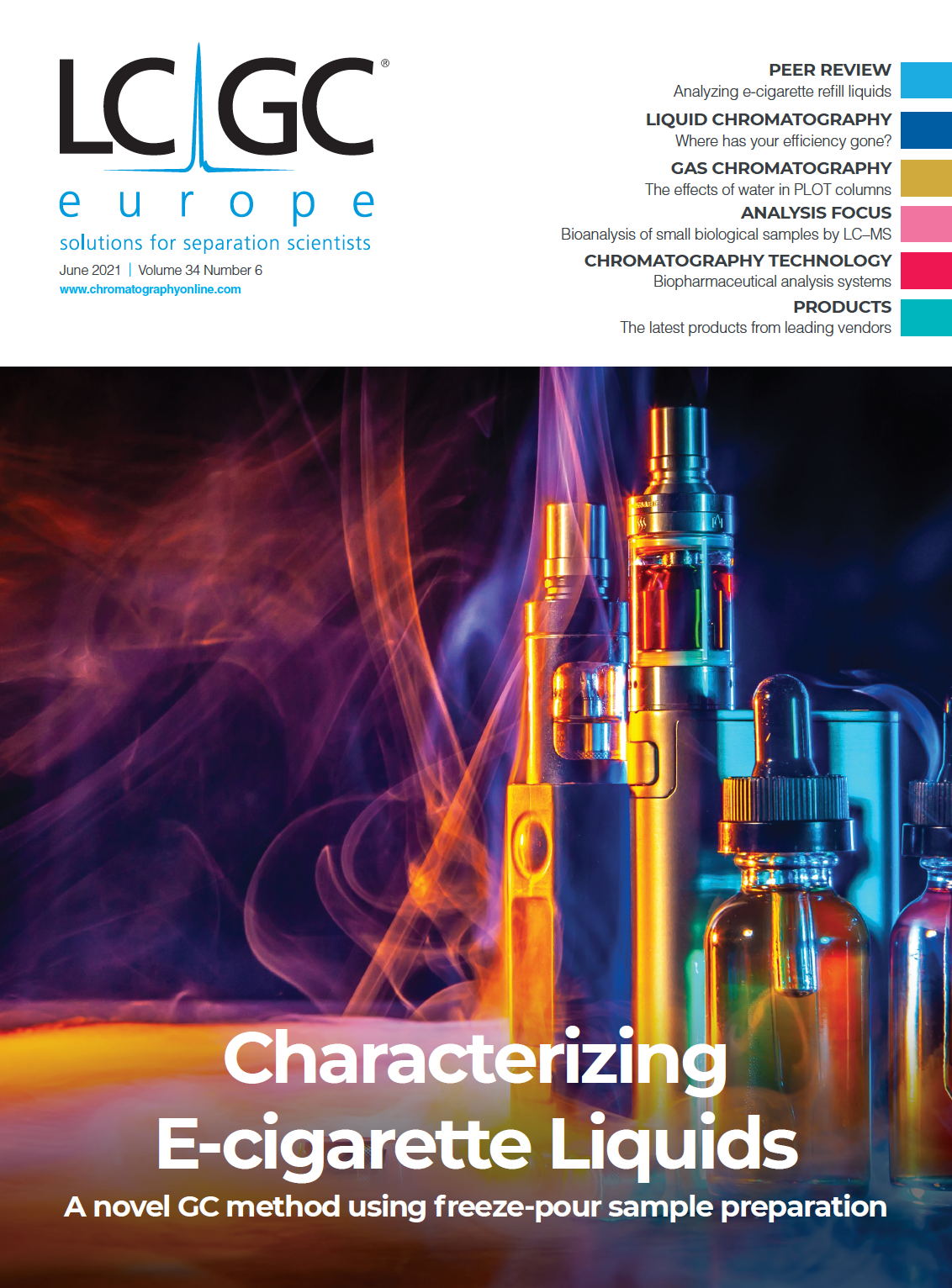
New Study Reviews Chromatography Methods for Flavonoid Analysis
April 21st 2025Flavonoids are widely used metabolites that carry out various functions in different industries, such as food and cosmetics. Detecting, separating, and quantifying them in fruit species can be a complicated process.
University of Rouen-Normandy Scientists Explore Eco-Friendly Sampling Approach for GC-HRMS
April 17th 2025Root exudates—substances secreted by living plant roots—are challenging to sample, as they are typically extracted using artificial devices and can vary widely in both quantity and composition across plant species.

.png&w=3840&q=75)

.png&w=3840&q=75)



.png&w=3840&q=75)



.png&w=3840&q=75)



